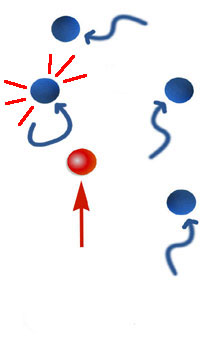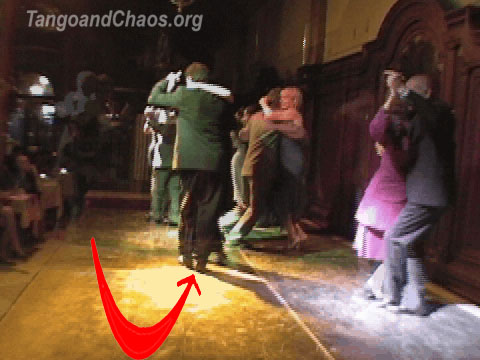
98 possible ganchos in the turn!"
-Gustavo Naveira
If you’re like me, you often feel frustrated about not getting to show your stuff in the milongas. I know, I know... you got the moves, but you just ain’t got the room. All those pesky dancers keep getting in the way. Well, I feel your pain. So we're going to show you a few tricks that are guaranteed to get you a little "elbow room". Previously, these techniques we're only available in expensive workshops and correspondence courses, but now, due to the magic of electronic computers, we're able to bring them directly into your home or office (or home-office) for free. Let's get started.
Step I: "Be My Bitch"
Here's the scenario: You are dancing quietly, enjoying the milonga like any other normal, unimaginative couple. But looks can be deceiving. The people around you are about to get a glimpse of the future—and for them, “Future Shock” will no longer be just the title of some book they were supposed to have read in college. You are about to send them back to school. You are about to reveal a "New Tango"!
In this tutorial, we'll keep it simple. We'll use only five couples on a small floor, and we'll take it one step at a time. We begin with the couples dancing normally, counter-clockwise around the ronda. You are the red billiard ball in the diagrams below:



The opening salvo: Slow down, so that space opens up in front of you (left picture). Then, throw a fast
U-turn to confront the couple behind you (middle picture). Finally, "hold and intimidate " (right pic).
The first step is to begin lagging (first picture on the left). As you slow down, couples will begin to back up behind you, and a gap will open up in front. (This is the space you're going to grab.) Now, if you got the eggs (or "Bolivianos" as we say down here in Rioplatense), it's time to fire the first shot. Take a deep breath, do a U-turn, and go right at the couple behind you (middle picture). Get right up in their grill, and let them know you mean business! Bust a pose, and hold it until they back down (last pic).
Step II: "House of Flying Daggers"



Seek target (fig. 1), launch kick (fig. 2), retreat and celebrate (fig. 3).
Now it’s time to deal with the couple in front of you. The key is to come out of nowhere, like a Hellfire missile streaking out of the sky into a terrorist training camp. Go right up to 'em and throw a kick (left picture). You don't actually have to make contact. A near miss should work—but they need to feel your power. And when they do, they will run away... and then it's game over! Now all you have to do is move to the center of the secured area (middle picture), and use it (last picture). You just caught the winning touchdown in the Super Bowl, and it's time to celebrate. Strut yo' stuff!
Now, we'll let Gustavo Naveira show you how it works in the real world. As the scene opens, he has just faced down the couple behind him. Then, he moves across the floor to deal with the couple dancing ahead of him. He backs into them, crowds them into the wall, and then throws a kick that lands blindly behind him, inches from their feet. Finally, he goes back across the floor, and fires a warning kick at the entire room. By the end of this short clip, he has driven everyone to the other side of the dance floor:

It happens fast, so we'll review it with still photographs. Here are the three keys to owning the floor:


1. "In Yo' Face": Turn against the line of dance, and push against the couple behind you until they back away.


2. "Shock and Awe": Move to the couple ahead of you in the ronda, and throw kicks to scare them.


3. "Strut yo' Stuff": You are now the new owner of enough floor space for four normal couples!
Step III: "The Landlord"
All of the yellow area is now yours, but you need to secure the perimeter. Just as the Aryan Brotherhood defends their weight bench in the yard at San Quentin, you must defend your turf against all comers. If you show weakness, selfish dancers will try to move back in:


The only way to maintain a secure perimeter is with a show of strength.
Want to keep other dancers away from you in a milonga? Then go to school on this:

You can see that Naveira has almost half of the floor to himself. This video demonstrates how you can use posturing, leg feints, and "dancing loco" to drive away other dancers. It's like biting the head off of a live chicken. You'll get everyone's attention, and they'll give you plenty of room.
After looking at the odd things Naveira was doing, I began to wonder what was going on inside his head. So I looked on the Internet, and I discovered a couple of interviews where he and his partner Fabian Salas discuss tango. They are amazing pieces of work. At times they approach the nuttiness of the “Our amps go to eleven” interview in Spinal Tap. Here are some of the highlights:
From the very beginning, Naveira and Salas were highly motivated to discover the secrets of tango—but when they talked to people who had been dancing for 50 or 60 years, apparently they didn't get the right answers. So they reluctantly decided that these “so-called great dancers” had “personal problems”, and they would have to look elsewhere. Salas remembers the fateful day when their real work began: “Gustavo, we are on our own… it's hard to talk to these people. We have to start learning from ourselves!”
 Salas (right) says their research basically involved finding out what they had to say to each other—and they worked at it tirelessly: "Talking! We spent hours playing billiards and talking. Taking coffees. They would kick us out of one place, and we'd go someplace else." They were looking for something big. “We have to come up with something that has the significance of a boleo!" Naveira tells Salas. "Imagine the first person that invented the gancho... how important that is!”
Salas (right) says their research basically involved finding out what they had to say to each other—and they worked at it tirelessly: "Talking! We spent hours playing billiards and talking. Taking coffees. They would kick us out of one place, and we'd go someplace else." They were looking for something big. “We have to come up with something that has the significance of a boleo!" Naveira tells Salas. "Imagine the first person that invented the gancho... how important that is!”
After weeks, or maybe even months, of hanging out and playing pool, their work paid off, because they discovered... the turn! “One day we came up with this realization that the fundamental structure in Argentine Tango was the turn… but you can't see it until you look for it!” Then, after further research, they found that there are three ways to step: “Every leg has three possible movements. You can do an open step, a front step or a back step. And that's it. You have to be in one of those three positions.” This was quickly followed by the finding that because most humans have two legs, you need to multiply that number by two—so there are actually six ways! “These realizations opened all the doors for us at once!” says Salas.
After these early discoveries, incredible things began to happen. Naveira remembers: “One night we discovered that there were 98 possible ganchos in the turn!” (Unfortunately, the interviewer neglected to ask whether you can do them all in the same turn.) They also discovered the ocho cortado: "One night Gustavo came up with this idea of the ocho cortado... he invented it, the milongueros are using it, and they don't even know where it came from." Sadly, he says, Susana Miller eventually stole it from them, and they no longer have it. And as we have seen above, they also discovered kicking.
At one point, the fawning interviewer asks Salas: “Where did the Cross System come from? Is that your work?” and Salas responds, “The cross-foot system? Yeah. We named things that most of the people don't know… we came up with the idea of showing the cross foot and calling it that.” (Alej was a little surprised at this, because she remembers that when her father was a young man, he was known for dancing vals cruzado. But whatever.)
As they labored on, they began to realize that tango really isn’t about culture or tradition at all, because it hasn’t been around long enough. “Tango is only 50 years old,” states Naveira. “But what we are doing is very important… it could last 3,000 years!”
The interviews wander, but they generally return to the same theme: That it was they who are responsible for all of the important things that exist in tango today. It's quite an achievement, and both Salas and Naveira justifiably bristle at calling their work Tango Nuevo, because it's so much more. At first, they called it CosmoTango—to denote a sort of all encompassing, "everything" kind of tango that reaches across the universe. Today, however, both have come to believe that the correct name for what they have achieved is simply Argentine Tango.
The message of the interviews is inescapable: Naveira and Salas are the true discoverers of tango! And like cockroaches and duct tape, their tango is destined to live on through global warming, economic collapse, and nuclear winter. A tango for the cosmos. A tango for 3,000 years!